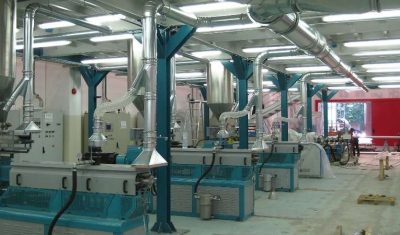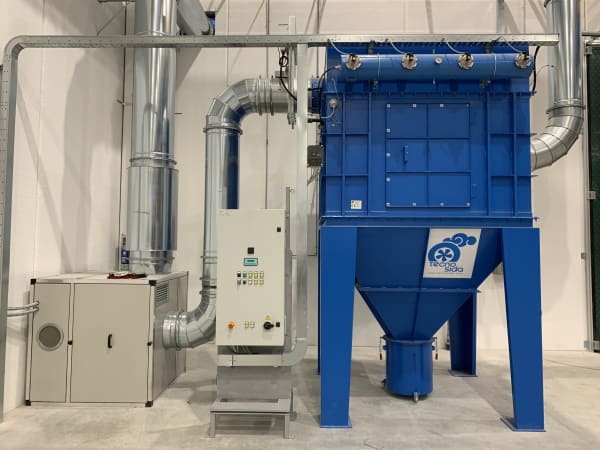Industrial dust filtration and collection technologies
Let’s find out which technologies are suitable for the abatement of ultra-fine, fine, coarse and explosive dust.
In this article we will discuss and better understand what industrial dust extraction and filtration equipment is, what types exist, how they work, and what advantages and limitations they show. The aim is to simplify the user’s choice and understanding of these technologies, and to do so, we will answer the following questions:
- what does it mean to filter dust?
- through which technologies can the abatement of this pollutant be achieved?
- how do the different systems work and what technical differences do they present?
What is dust filtration?

Dust filtration is a process used to remove, with the highest possible efficiency, the dust present in an air stream. In standard production cycles, irrespective of the final product made, it is in fact normal to emit unwanted dust; just think of the processing of construction materials, the mixing of compounds, mechanical processing and, in general, all activities known to release particles into the environment. This dust poses a risk to the health of operators and the environment, and it is therefore essential to do something to reduce its concentration and comply with the emission limits set by regulations. The first fundamental aspect is the provision of suitable extraction hoods, whether fixed or mobile, and/or articulated extraction arms positioned at sensitive points in order to capture dust directly at its source.
But once the dust has been extracted, what is to be done? Of course, they cannot be released into the outside environment without a filtration process, so they must be conveyed to a suitable dust collector. Let us see together which technologies are available for this purpose.
What types of industrial filters are used to eliminate dust?
To avoid damaging the environment and annoying the neighbourhood with our dust, it is possible to install various systems that filter it out of the aeriform flow. In some cases, it is also possible to recover it for reuse within production or resell it as a waste product.
The main industrial dust filtration and collection technologies include:
- Bag filters;
- Cartridge filters;
- Cyclone separators;
- Multi-cyclones;
- Cell or pocket filters;
- Electrostatic precipitators;
- Venturi Scrubber
Comparison table of dust filtration and dust collection technologies
| Product type | Dust type | Abatement efficiency | Plant cost | Maintenance costs | Temperature | Strengths |
|---|---|---|---|---|---|---|
| Bag filter | Ultra-fine and fine dust | 99.99% | High | Low | Up to 250°C |
|
| Cartridge filter | Ultra-fine and fine dust | 99.99% | Medium – High | Low | Up to 70°C |
|
| Cyclones | Coarse dust | 90% | Low | Zero | From a few degrees to more than 800°C |
|
| Multi-cyclones | Fine and coarse dust | 70% with dust sizes from 7-10 microns | Medium | Zero | From a few degrees to more than 800°C |
|
| Pocket filter | All dust types | 70-90% | Low | Low | Up to 80°C |
|
| Electrostatic precipitator | Ultra-fine and fine dust | 99% | High | Medium | Up to 800°C |
|
| Venturi scrubber | Fine dust | 99% | High | Medium | Up to 800°C |
|
The table above summarises the characteristics and strengths/weaknesses of the technologies mentioned. It should be considered as a generic indication, to be verified according to the specific technical situation of the case.
Let us now look in a little more detail at how these technologies work, thus answering our third question.
How do dust filtration and dust collection technologies work?
Industrial filters used for dust collection are different and the choice of the most suitable one depends mainly on the following factors:
- air flow rate to be treated;
- temperature;
- humidity;
- dust concentration;
- dust particle size;
- dust nature and type of production
With these simple data, appropriately communicated, Tecnosida® is able to study and propose the best system for dust abatement requirements. In fact, each filtration system has strengths and weaknesses mainly linked to the operating system. Let us explore this aspect together by analysing the characteristics of the main dust filtration technologies!
Cyclone separators
The operation of cyclones is based on centrifugal force. The cyclone consists of two concentric cylinders: the outer one usually ends in a cone shape, while the inner one conveys the treated effluent to the outlet. This conformation, combined with the tangential inlet, allows the effluent to make a spiroidal motion in the part left free between the two cylinders. The aeriform flow is then forced by the geometry of the system to exit the inner cylinder after performing a series of eddies around it. This centrifugal motion, together with the force of gravity, allows the heavier particles to fall towards the lower part of the system, where they are recovered.
Dust filtration and collection technologies: multi-cyclones
Multicyclones are dust filtration technologies consisting of several cyclones: this structure makes it possible to eliminate even smaller particles that cannot be treated with a simple cyclone, even though the operating principle is identical. To better understand the functionality of our Turbovortex® multicyclone, you can read our Case History “Class V certification for biomass heat generators” which explains how this technology can be applied to biomass boilers.
Bag and cartridges filters

Bag or cartridge filters are systems that, instead of exploiting physical laws, use filter media to purify the air and retain polluting particles.
Let us clarify immediately that the filter medium is the element that passively carries out the filtration. It is chosen according to the type and application required, and there are numerous variants (paper, non-woven fabrics, nets, wire cloths, ceramics, etc.).
In these technologies, the particles are deposited on the surface of the medium, creating a ‘dust panel’ (called ‘cake’) which actively performs dust filtration during operation, while the bags act as a support for this panel. When a certain differential pressure between the dirty and clean sides of the filter is reached, thanks to an appropriate cleaning system, the dust is shaken off the filter media and collected inside the collection hoppers located at the bottom of the filter.
The cleaning system allows the filter to be kept efficient at all times and, at the same time, facilitates the recovery of dust at the bottom of the filter.
The efficiency of these machines is higher than with cyclones because the operating principle is more efficient and the choice of filter media can allow particles in the micron range to be filtered.
The choice between bag or cartridge filter is made by evaluating the nature of the pollutants, process, dust and other physical quantities involved. For a more in-depth look at this issue, we recommend reading the article where we describe the strengths and weaknesses of the two filter media and criteria for the choice. Furthermore, to better understand the fields of application of the two technologies, we recommend that you read the following Case Histories:
- ATEX equipment for flammable dust collection, extraction and filtration in the metallurgical sector concerning the use of bag and cartridge filters for the treatment of dust in potentially explosive atmospheres (ATEX);
- Dust collection, extraction and filtration systems in the rubber plastic sector relating to three realisations in the production of elastomers and rubber compounds.
Cell and pocket filters
Pocket or cell filtration systems are also equipped with filter media that remove dust from the aeriform flow. The cells used, in contrast to self-cleaning systems, have an active behaviour, i.e. their structure allows them to trap dust by removing it from the aeriform flow. This is why you have several cells in series with an incremental filtration efficiency. In fact, each cell is tested according to a specific standard, namely ISO 16890 or EN 1822 (for HEPA filters), which defines its efficiency. Thanks to their modularity, these filters can achieve very high efficiencies (up to 99.9999% and penetration < 0.0001%) for dust as well as treating complex effluents. In fact, activated carbon or coalescing cells can also be inserted in this type of machines to remove any VOCs or oily mists. Due to the active participation of the filter elements in the purification processes and the fact that they cannot be cleaned or regenerated, the substances to be removed must be present in small quantities otherwise the elements quickly become saturated and must be replaced.
Dust filtration and dust collection technologies: electrostatic precipitators
Electrostatic precipitators are also known as electrostatic filters. They exploit an induced potential difference between two electrodes (emission and collection) to capture pollutant particles before the purified effluent flows to the stack. In practice, the induced potential difference between the two electrodes generates an electric field that ionises the area around the electrodes.
These ions positively or negatively charge the pollutant particles so that, thus charged, they are attracted to the electrodes, removing them from the flow.
Once the particles have been captured, they can be removed from the electrodes with a dry or wet cleaning system.
Venturi Scrubbers
Control systems called Venturi scrubbers are wet systems that use the geometry of the Venturi tube to remove dust. Liquid and air come into close contact inside the Venturi throat, causing pollutant particles to flow towards the liquid, where they are trapped. To find out more about how the Wetclean scrubber works, we recommend reading our Case History, which presents four different applications of this technology: Wet scrubber for odour, VOC and inorganic vapour treatment.

Follow our newsletter for more information and contact us for any needs: we will design the best solution for your business!